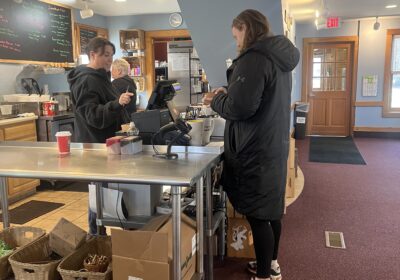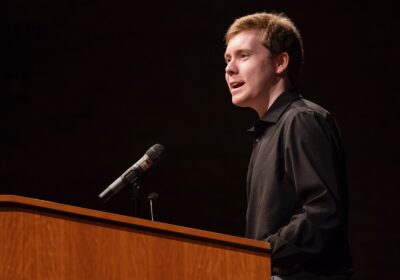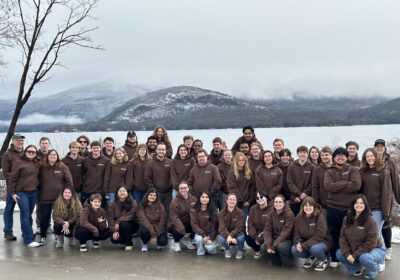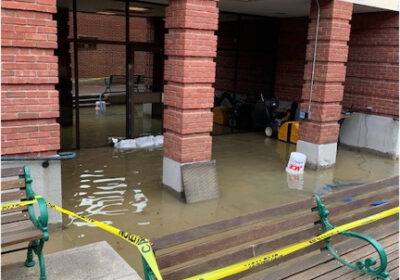Castleton Student saves a life

Sara Novenstern / Castleton contributor
Sarah Czarnecki
When people think of cancer they think of this terrible disease that is typically treated by radiation and chemotherapy. But what if you could save a cancer patient’s life just by donating blood stem cells?
Sarah Czarnecki, a Castleton senior majoring in special education, used her gift of helping people to help save a cancer patient’s life.
Czarnecki donated her peripheral blood stem cells just a few months ago to a patient with leukemia. The match was made through the Be the Match organization. Czarnecki’s experience was a roller coaster ride of emotions, feeling some pain from the donating process, but feeling that she did a great deed for someone in need in the end.
The process of donating blood stem cells is time consuming, and there’s an element of pain involved, as well as a huge commitment from the donor. Before donation, the donor has to go through a process called apheresis. Four to five days before apheresis the donor might be given a medication to increase the count of stem cells in the bloodstream. During this process the donor has a central venous catheter put in a large vein to remove blood. The blood is put through a machine that removes the stem cells which takes a few hours to complete.
“It was painful, not too painful, but I was set up on a machine where I had one very stiff needle in my right arm, and I could not move that arm. In my other arm I had a returner IV,” she said. “I was at Dartmouth Hitchcock from 7 a.m. until 1 p.m. on Thursday. I got news that they didn’t get everything they needed so I had to come back the next day from 7 a.m. to 1 p.m. It was a long process, and I had to keep the returner IV in my left arm which was painful so I didn’t really sleep that great that night.”
When a patient’s life is at stake, the donor can feel extremely nerve-wracked and anxious. If the transplantation works in the patient’s favor it can be immensely rewarding for the donor.
“It’s very rewarding. At first I was very skeptical, because I wasn’t sure what to expect, because I didn’t know who she was. Once everything was set and done two months ago, I had my blood follow up and she’s in remission, so that makes it so much more rewarding,” Czarnecki said.
Czarnecki’s courage and bravery to help someone fighting this disease has gained support from people within the Castleton community. Karen Sanborn, coordinator of the media center, gave her insight on the decision to donate.
“I think it’s awesome. I’m on the registry. I just think it’s a wonderful program to be involved in, and the fact that you can save someone’s life and only feel a minimal amount of pain,” Sanborn said.
In a situation where the patient could potentially not benefit from stem cell transplantation, it could be devastating and even result in death. Czarnecki felt trepidation as she went through this process, but has recognized the importance of saving a life, and will eventually meet the patient as she is in remission.
” Unfortunately I can’t meet her until next year, just because of confidentiality, and if things don’t work out they don’t want us to build a relationship and then have something happen. She did send me a card and I’m in the process of getting together a letter to send to her,” Czarnecki said.
Czarnecki’s involvement with Be The Match began on a whim, but through the experience has changed her life.
“I signed up for the Be the Match program my first year here in 2012, and I didn’t think much about it. My friend just said ‘Let’s go sign up!’ I just said ‘Okay, whatever this is,’ and I got the call over spring break last year saying I was a potential match and I kind of freaked out,” she said.
If people within our community are educated about health issues they too can get involved and save a life.
“It’s great that Deb [Choma] is running a class through the Be the Match organization. Also this article will inform people and let people know helping can be positive,” Sanborn said.
The Be the Match organization has helped students like Czarnecki leave an imprint on another life. Choma runs the donor drive on campus and is a part of the organization. Choma has witnessed many matches and miracles through her years being involved with this organization.
“This organization is absolutely successful. Every single match is truly a success. In one year, donors get to meet the person they donated to. It’s so cool. It’s a miracle. It’s like a baby being born,” Choma said. “The age population I work with comes up with frequent matches. The population is young, healthy, and vibrant so this process seems to be more successful with the younger generation. If students sign up for the international registry there will be more success because the matches are not just confined to the United States. DNA is collected from the students and then you can possibly go through 100,000 potential donors, and the chance of coming up with a match is more likely on the international registry. In the past seven or eight years I’ve been involved, there have been several matches, and it’s a miracle when it happens.”
Health issues are unavoidable, and instead of simply standing on the sidelines people can contribute to help those suffering with diseases. Getting involved in your community, or educating yourself and others on health issues will raise awareness. Students like Czarnecki joined an organization on a whim, and it ended up being a life changing experience.






